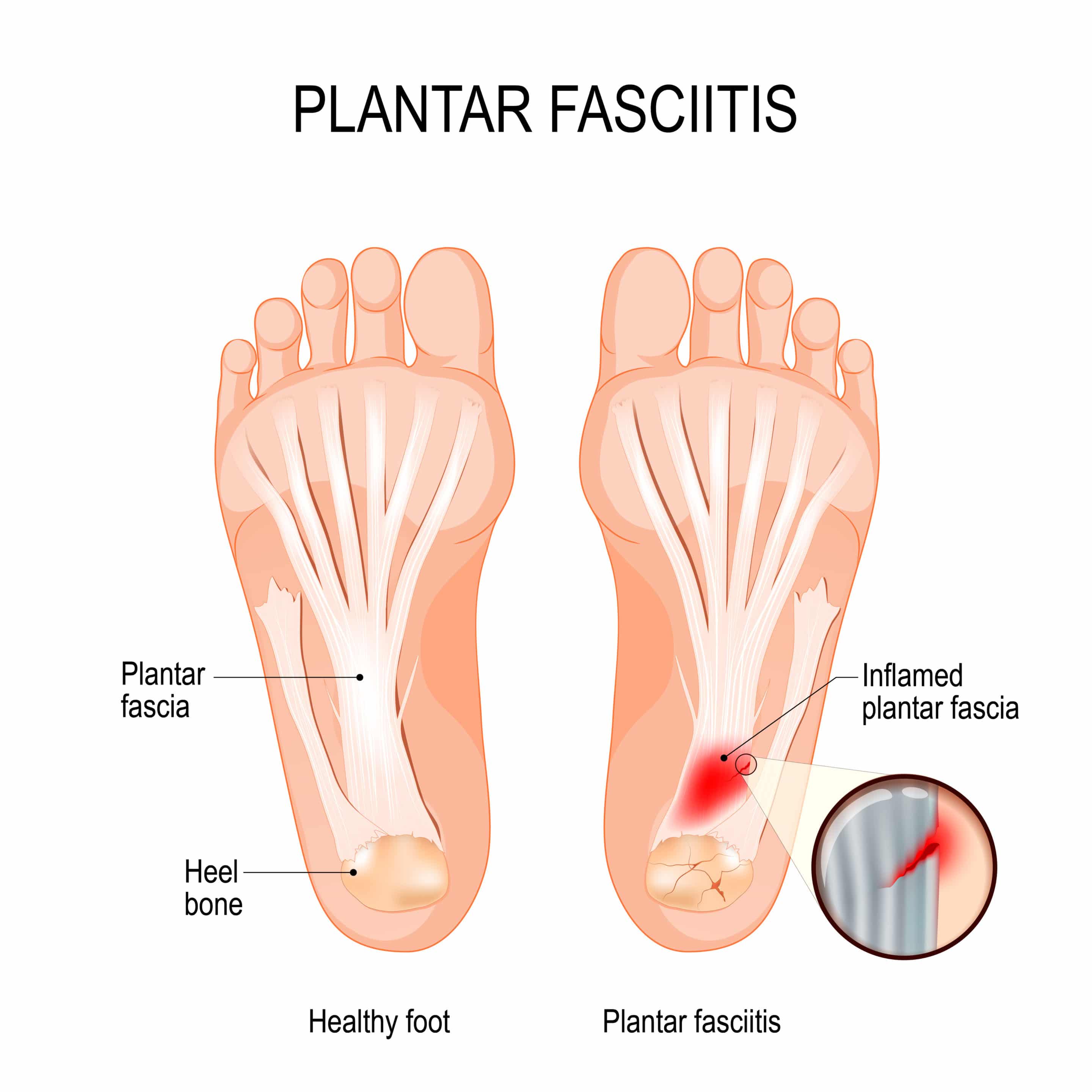Plantar fasciitis is a common cause of heel pain, characterized by tears and inflammation in the plantar fascia—a thick, tough band of tissue running from the heel to the base of the toes. This tissue supports the arch of your foot, and when overstressed, it can become damaged, leading to pain, especially along the underside of the heel.
Common Symptoms
The most notable symptom of plantar fasciitis is stabbing pain in the heel, particularly during the early morning or after long periods of inactivity. This pain often decreases as the day goes on but can return after extended periods of standing or sitting.
Main Causes of Plantar Fasciitis
Several factors can contribute to plantar fasciitis, often in combination:
- Inadequate Footwear: Shoes lacking proper support and cushioning can lead to overstressing the plantar fascia.
- Foot Structure: Issues like flat arches, high arches, or overpronation can naturally contribute to increased stress on the plantar fascia.
- Occupational Hazards: Jobs that require prolonged standing or walking on hard surfaces can exacerbate the condition.
- Active Lifestyle: High-impact activities, especially without sufficient rest or proper training techniques, can lead to plantar fasciitis.
- Excess Weight: Increased body weight places additional pressure on the plantar fascia.
Physical Therapy, Stretches, and Exercises
Physical therapy is essential for effectively treating plantar fasciitis. It includes specific stretches and exercises designed to relieve tension in the plantar fascia and strengthen the supporting muscles. Common exercises include:
- Calf Stretches: Stretching the calf muscles can reduce stress on the plantar fascia and Achilles tendon.
- Plantar Fascia Stretches: Stretching the bottom of your foot helps alleviate pain and improve flexibility.
- Toe Stretches: Stretching the toes can help improve the condition of the plantar fascia.
- Strengthening Exercises: Building strength in the foot’s muscles supports the arch and reduces strain on the fascia.
Achilles Tendinitis vs. Plantar Fasciitis
Both Achilles tendinitis and plantar fasciitis involve inflammation and pain in the foot, but they affect different areas:
- Achilles Tendinitis: This condition involves the tendon connecting the calf muscles to the heel bone. Pain is typically felt at the back of the heel and can extend up into the lower leg.
- Plantar Fasciitis: This condition involves the tissue supporting the arch of the foot. Pain is typically felt on the underside of the heel and can spread along the arch.
Despite these differences, both conditions can benefit from similar treatments such as stretching, strengthening exercises, and proper footwear. Understanding the specific characteristics of each can help tailor the most effective treatment plan.
Treatment at Home
If you’re dealing with chronic or recurring foot pain that isn’t responding to simple at-home therapy strategies such as RICE (rest, ice, compression, elevation), it’s important to seek professional help. Early intervention can prevent the condition from worsening and can often provide quicker relief.
Some effective at-home treatments for plantar fasciitis include:
- Rest: Refrain from activities that intensify the pain.
- Ice: Apply ice to the affected area to reduce inflammation.
- Compression: Apply a compression bandage to support the foot and minimize swelling.
- Elevation: Elevate the foot to decrease swelling.
Effective Treatments for Plantar Fasciitis
Early intervention is key to managing plantar fasciitis. Here are some common treatments:
- Corticosteroid Injections: Quick pain relief through targeted injections.
- Stretching and Exercises: Relieve tension in the fascia and strengthen supporting muscles.
- Supportive Footwear: Transition to shoes with better arch support to reduce stress on the plantar fascia.
- Orthotics: Custom insoles provide additional cushioning and support, improving foot mechanics and reducing injury risk.
- Night Splints: Keep the plantar fascia elongated during sleep, promoting healing and reducing morning pain.
- Activity Adjustments: Modify exercise routines to reduce heel stress, such as switching to low-impact activities or running on flatter terrain.
- Workplace Changes: Implement modifications to reduce strain during work, such as using anti-fatigue mats or adjusting workstations.
When to Seek Help
If home treatments like RICE (rest, ice, compression, elevation) are not effective, it’s essential to seek professional help. Early treatment can prevent the need for more aggressive interventions, such as surgery, which is only necessary in rare, severe cases.
Schedule an Appointment
Don’t let plantar fasciitis keep you from enjoying life. Contact the Texas Foot & Ankle Center for a comprehensive diagnosis and personalized treatment plan. Call our office at (214) 660-0777, or connect with us online to schedule your appointment. Plantar fasciitis is a treatable condition. Reach out to us for professional care and start your journey to pain-free feet.
